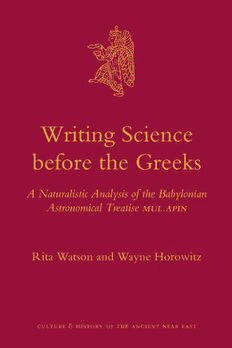Table Of ContentWriting Science before
the Greeks
Culture and History of the
Ancient Near East
Founding Editor
M. H. E. Weippert
Editor-in-Chief
Thomas Schneider
Editors
Eckart Frahm (Yale University)
W. Randall Garr (University of California, Santa Barbara)
B. Halpern (Pennsylvania State University)
Theo P. J. van den Hout (Oriental Institute)
Irene J. Winter (Harvard University)
VOLUME 48
Writing Science before
the Greeks
A Naturalistic Analysis of the Babylonian
Astronomical Treatise MUL.APIN
By
Rita Watson and Wayne Horowitz
LEIDEN • BOSTON
2011
This book is printed on acid-free paper.
Library of Congress Cataloging-in-Publication Data
Watson, Rita
Writing science before the Greeks : a naturalistic analysis of the Babylonian astro-
nomical treatise MUL.APIN / by Rita Watson and Wayne Horowitz.
p. cm. — (Culture and history of the ancient Near East, ISSN 1566-2055 ; v. 48)
Includes bibliographical references and index.
ISBN 978-90-04-20230-6 (hardback : alk. paper) 1. Astronomy, Assyro-Babylonian.
2. Akkadian language—Texts. I. Horowitz, Wayne, 1957– II. Title. III. Series.
QB19.W38 2011
520.935—dc22
2010051431
ISSN 1566-2055
ISBN 978 90 04 20230 6
Copyright 2011 by Koninklijke Brill NV, Leiden, The Netherlands.
Koninklijke Brill NV incorporates the imprints Brill, Hotei Publishing,
IDC Publishers, Martinus Nijhoff Publishers and VSP.
All rights reserved. No part of this publication may be reproduced, translated,
stored in a retrieval system, or transmitted in any form or by any means, electronic,
mechanical, photocopying, recording or otherwise, without prior written permission
from the publisher.
Authorization to photocopy items for internal or personal use is granted by
Koninklijke Brill NV provided that the appropriate fees are paid directly to
The Copyright Clearance Center, 222 Rosewood Drive, Suite 910,
Danvers, MA 01923, USA.
Fees are subject to change.
In tribute to Herman Hunger and David R. Olson for their lifelong
achievements in our respective fields; and in memory of our friend
John Britton.
CONTENTS
List of Illustrations ...................................................................... xvii
Acknowledgments ....................................................................... xix
Foreword ..................................................................................... xxi
Introduction ................................................................................ xxiii
Chapter One MUL.APIN ....................................................... 1
1.1 The Text ........................................................................ 1
1.2 Form .............................................................................. 2
1.3 Date of Composition ..................................................... 3
1.4 MUL.APIN and the Scribal Tradition ........................ 6
1.5 Sequence in MUL.APIN .............................................. 7
1.5.1 Sequence: Procedural Considerations ............... 8
1.6 Mesopotamians and Moderns ...................................... 10
1.7 Analytic Considerations: Why We Chose
MUL.APIN ................................................................... 12
1.8 Conclusion ..................................................................... 14
Chapter Two Writing and Conceptual Change ..................... 15
2.1 The Cuneiform Scribal Tradition ................................. 16
2.1.1 The Cuneiform Lists and Conceptions of
Language ............................................................ 17
2.2 Writing, Cognition, and Culture ................................... 18
2.2.1 Literacy and the Brain ....................................... 19
2.2.2 Naturalistic Approaches ..................................... 20
2.2.3 Cognitive Evolution ........................................... 21
2.2.4 Cultural Variation .............................................. 23
2.2.5 Cultural Transmission ....................................... 24
2.3 Writing and Conceptual Change .................................. 25
2.3.1 Writing and Rationality ..................................... 26
2.3.2 The Greeks and the “Great Divide” ................. 26
2.3.3 Moderns, Media, and Materialism .................... 30
2.3.4 Pragmatics and the Uses of Writing ................. 32
2.3.5 Permanence, Memory, and the Archival Uses
of Texts .............................................................. 33
viii contents
2.4 A Model of Writing and Conceptual Change .............. 35
2.4.1 Writing and Cultural Transmission .................. 35
2.4.2 Writing as Communication ............................... 36
2.4.3 Writing Recalibrates Inferential Environments 38
2.4.4 Writing and Rationality ..................................... 40
2.5 Conclusion: Summary of Pre-Analytic Assumptions .... 42
Chapter Three Terms of Analysis ........................................... 45
3.1 The Language of Space and Time ............................... 45
3.1.1 The Language of Space ..................................... 46
3.1.2 Coordinating Systems or Frames of
Reference ............................................................ 47
3.1.3 The Language of Time ...................................... 48
3.2 Deixis, Indexical Expressions, and Context ................. 51
3.3 Categories and Concepts ............................................... 53
3.3.1 Kinds of Concepts ............................................. 53
3.4 Naming .......................................................................... 54
3.5 Definition ....................................................................... 55
3.5.1 Stipulative Definition ......................................... 56
3.6 Assumptions and Axioms .............................................. 58
3.7 Rhetorical Concerns ...................................................... 58
Chapter Four MUL.APIN: Text and Analysis ....................... 61
A Note on the Form of the Akkadian Text of
MUL.APIN ............................................................................. 61
4.1 Section a, MUL.APIN I i 1–ii 35 ................................. 63
4.1.1 Astronomical Content ........................................ 63
4.1.2 Textual Form ..................................................... 63
4.1.3 Translated Text ................................................. 64
4.1.4 Analysis ............................................................... 66
4.1.4.1 Discourse Forms: List Structure ......... 66
4.1.4.2 Discourse Forms: Time and Space .... 66
4.1.4.3 Minor Textual Form: The Planets ..... 67
4.1.5 Categories ........................................................... 68
4.2 Sections b–d, MUL.APIN I ii 36–I iii 12 ..................... 69
4.2.1 Astronomical Content ........................................ 69
4.2.2 Textual Form ..................................................... 69
4.2.3 Translated Text ................................................. 69
4.2.4 Analysis ............................................................... 72

